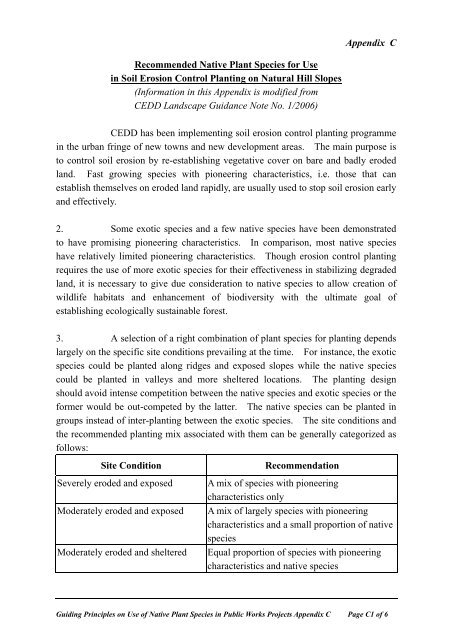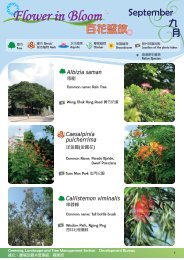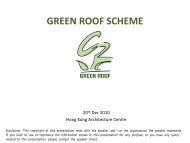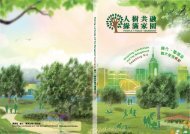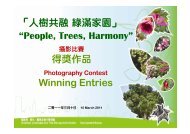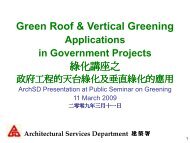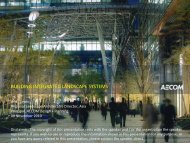Recommended Native Plant Species for Use in Soil Erosion Control ...
Recommended Native Plant Species for Use in Soil Erosion Control ...
Recommended Native Plant Species for Use in Soil Erosion Control ...
You also want an ePaper? Increase the reach of your titles
YUMPU automatically turns print PDFs into web optimized ePapers that Google loves.
Appendix C<br />
<strong>Recommended</strong> <strong>Native</strong> <strong>Plant</strong> <strong>Species</strong> <strong>for</strong> <strong>Use</strong><br />
<strong>in</strong> <strong>Soil</strong> <strong>Erosion</strong> <strong>Control</strong> <strong>Plant</strong><strong>in</strong>g on Natural Hill Slopes<br />
(In<strong>for</strong>mation <strong>in</strong> this Appendix is modified from<br />
CEDD Landscape Guidance Note No. 1/2006)<br />
CEDD has been implement<strong>in</strong>g soil erosion control plant<strong>in</strong>g programme<br />
<strong>in</strong> the urban fr<strong>in</strong>ge of new towns and new development areas. The ma<strong>in</strong> purpose is<br />
to control soil erosion by re-establish<strong>in</strong>g vegetative cover on bare and badly eroded<br />
land. Fast grow<strong>in</strong>g species with pioneer<strong>in</strong>g characteristics, i.e. those that can<br />
establish themselves on eroded land rapidly, are usually used to stop soil erosion early<br />
and effectively.<br />
2. Some exotic species and a few native species have been demonstrated<br />
to have promis<strong>in</strong>g pioneer<strong>in</strong>g characteristics. In comparison, most native species<br />
have relatively limited pioneer<strong>in</strong>g characteristics. Though erosion control plant<strong>in</strong>g<br />
requires the use of more exotic species <strong>for</strong> their effectiveness <strong>in</strong> stabiliz<strong>in</strong>g degraded<br />
land, it is necessary to give due consideration to native species to allow creation of<br />
wildlife habitats and enhancement of biodiversity with the ultimate goal of<br />
establish<strong>in</strong>g ecologically susta<strong>in</strong>able <strong>for</strong>est.<br />
3. A selection of a right comb<strong>in</strong>ation of plant species <strong>for</strong> plant<strong>in</strong>g depends<br />
largely on the specific site conditions prevail<strong>in</strong>g at the time. For <strong>in</strong>stance, the exotic<br />
species could be planted along ridges and exposed slopes while the native species<br />
could be planted <strong>in</strong> valleys and more sheltered locations. The plant<strong>in</strong>g design<br />
should avoid <strong>in</strong>tense competition between the native species and exotic species or the<br />
<strong>for</strong>mer would be out-competed by the latter. The native species can be planted <strong>in</strong><br />
groups <strong>in</strong>stead of <strong>in</strong>ter-plant<strong>in</strong>g between the exotic species. The site conditions and<br />
the recommended plant<strong>in</strong>g mix associated with them can be generally categorized as<br />
follows:<br />
Site Condition<br />
Severely eroded and exposed<br />
Moderately eroded and exposed<br />
Moderately eroded and sheltered<br />
Recommendation<br />
A mix of species with pioneer<strong>in</strong>g<br />
characteristics only<br />
A mix of largely species with pioneer<strong>in</strong>g<br />
characteristics and a small proportion of native<br />
species<br />
Equal proportion of species with pioneer<strong>in</strong>g<br />
characteristics and native species<br />
Guid<strong>in</strong>g Pr<strong>in</strong>ciples on <strong>Use</strong> of <strong>Native</strong> <strong>Plant</strong> <strong>Species</strong> <strong>in</strong> Public Works Projects Appendix C Page C1 of 6
Appendix C<br />
4. On severely eroded and exposed site, the land is usually barren and the<br />
soil quality is poor. For the plant to grow under these conditions, plant species with<br />
pioneer<strong>in</strong>g characteristics such as nitrogen fix<strong>in</strong>g capability, resistance to w<strong>in</strong>d and<br />
tolerance to drought should be selected <strong>for</strong> plant<strong>in</strong>g. Silvicultural works such as<br />
prun<strong>in</strong>g and selective th<strong>in</strong>n<strong>in</strong>g of exotic species 1 and enrichment plant<strong>in</strong>g with native<br />
species may be carried out at a later stage <strong>in</strong> order to accelerate the process of natural<br />
succession (see paragraph 7 below). If the site is near coastal area or prone to<br />
frequent hill fires, a m<strong>in</strong>or adjustment of species composition may be made to <strong>in</strong>clude<br />
species suitable <strong>for</strong> coastal plant<strong>in</strong>g, such as Casuar<strong>in</strong>a equisetifolia, Hibiscus<br />
tiliaceus, Thespesia populnea etc, and species with the ability to regenerate after fire,<br />
such as Acacia confusa, Lophostemon confertus, Schima superba, Schima wallichii<br />
etc.<br />
5. On moderately eroded and exposed site where sign of progressive<br />
deterioration of soil surface is obvious, a plant<strong>in</strong>g mix of up to 75% of species with<br />
pioneer<strong>in</strong>g characteristics is recommended. <strong>Native</strong> species can make up the<br />
rema<strong>in</strong><strong>in</strong>g composition. Aga<strong>in</strong>, if the site is near coastal area or prone to frequent<br />
hill fires, a m<strong>in</strong>or adjustment of species composition may be made to <strong>in</strong>clude species<br />
suitable <strong>for</strong> coastal plant<strong>in</strong>g and species with the ability to regenerate after fire.<br />
6. On moderately eroded and sheltered site, the objective is to establish a<br />
lush woodland with the long term goal of achiev<strong>in</strong>g an ecologically susta<strong>in</strong>able <strong>for</strong>est.<br />
<strong>Native</strong> species can play a greater role <strong>in</strong> the plant<strong>in</strong>g composition. Apart from<br />
plant<strong>in</strong>g species with pioneer<strong>in</strong>g characteristics, the choice of species can be widened<br />
to <strong>in</strong>clude some native broadleaf species to facilitate ecological succession.<br />
7. On previously af<strong>for</strong>ested or rehabilitated sites, different degree of<br />
natural regeneration should have occurred depend<strong>in</strong>g on the type of plant<strong>in</strong>g mix used<br />
and the degree of site improvement after rehabilitation plant<strong>in</strong>g. Silvicultural works<br />
such as prun<strong>in</strong>g and selective th<strong>in</strong>n<strong>in</strong>g of exotic species may be carried out <strong>in</strong> order to<br />
accelerate the process of natural succession. Where natural regeneration is sparse,<br />
underplant<strong>in</strong>g of native species, especially those shade tolerant species, may be<br />
planted so that the understorey <strong>for</strong>med can be enriched with a wider range of native<br />
species.<br />
8. A list of species with pioneer<strong>in</strong>g characteristics and a list of native<br />
1<br />
The operation of selective th<strong>in</strong>n<strong>in</strong>g of exotic species should be carefully adm<strong>in</strong>istered to avoid<br />
misunderstand<strong>in</strong>g by the general public as the operation might <strong>in</strong>volve tree removal by way of fell<strong>in</strong>g.<br />
Guid<strong>in</strong>g Pr<strong>in</strong>ciples on <strong>Use</strong> of <strong>Native</strong> <strong>Plant</strong> <strong>Species</strong> <strong>in</strong> Public Works Projects Appendix C Page C2 of 6
Appendix C<br />
species recommended <strong>for</strong> use <strong>in</strong> erosion control plant<strong>in</strong>g are shown <strong>in</strong> Table 1 and<br />
Table 2 respectively. Officers should also attempt to use other available native<br />
species on a trial basis besides us<strong>in</strong>g those with record of proven success.<br />
Guid<strong>in</strong>g Pr<strong>in</strong>ciples on <strong>Use</strong> of <strong>Native</strong> <strong>Plant</strong> <strong>Species</strong> <strong>in</strong> Public Works Projects Appendix C Page C3 of 6
Appendix C<br />
Table 1 - <strong>Recommended</strong> list of species with pioneer<strong>in</strong>g characteristics <strong>for</strong> soil erosion<br />
control plant<strong>in</strong>g <strong>in</strong> Hong Kong<br />
Botanical name<br />
Acacia auriculi<strong>for</strong>mis*<br />
Acacia confusa*<br />
Acacia mangium*<br />
Castanopsis fissa<br />
Casuar<strong>in</strong>a equisetifolia*<br />
Eucalyptus robusta* #<br />
Eucalyptus tereticornis* #<br />
Eucalyptus torelliana* #<br />
Gordonia axillaris<br />
Lophostemon confertus*<br />
Schima superba<br />
Schima wallichii*<br />
中 文 名 稱<br />
耳 果 相 思<br />
台 灣 相 思<br />
大 葉 相 思<br />
黧 蒴 錐<br />
木 麻 黃<br />
大 葉 桉<br />
細 葉 桉<br />
毛 葉 桉<br />
大 頭 茶<br />
紅 膠 木<br />
木 荷<br />
紅 荷<br />
* Exotic species<br />
# Eucalyptus species should not be used on plant<strong>in</strong>g site prone to frequent fires.<br />
Guid<strong>in</strong>g Pr<strong>in</strong>ciples on <strong>Use</strong> of <strong>Native</strong> <strong>Plant</strong> <strong>Species</strong> <strong>in</strong> Public Works Projects Appendix C Page C4 of 6
Appendix C<br />
Table 2 - <strong>Recommended</strong> list of native species <strong>for</strong> erosion control plant<strong>in</strong>g <strong>in</strong> Hong<br />
Kong<br />
Botanical name<br />
Alangium ch<strong>in</strong>ense<br />
Aporusa dioica +<br />
Bridelia tomentosa +<br />
Bischofia javanica<br />
Castanopsis fabri<br />
Castanopsis fissa +<br />
Celtis s<strong>in</strong>ensis<br />
Choerospondias axillaris<br />
C<strong>in</strong>namomum parthenoxylon<br />
Cyclobalanopsis edithiae +<br />
Cyclobalanopsis neglecta<br />
Diospyros morrisiana<br />
Elaeocarpus ch<strong>in</strong>ensis<br />
Elaeocarpus sylvestris<br />
Endospermum ch<strong>in</strong>ense<br />
Eriobotrya fragrans<br />
Ficus microcarpa<br />
Gordonia axillaris +<br />
Ilex rotunda var. microcarpa +<br />
Liquidambar <strong>for</strong>mosana<br />
Lithocarpus harlandii<br />
Litsea cubeba +<br />
Litsea glut<strong>in</strong>osa +<br />
Litsea rotundifolia var. oblongifolia<br />
Macaranga tanarius<br />
Machilus breviflora +<br />
Machilus chekiangensis +<br />
Machilus pauhoi<br />
Machilus thunbergii +<br />
Mallotus paniculatus +<br />
Melastoma candidum +<br />
Melastoma sangu<strong>in</strong>eum +<br />
Microcos paniculata<br />
中 文 名 稱<br />
八 角 楓<br />
銀 柴<br />
土 密 樹<br />
秋 楓<br />
羅 浮 錐<br />
黧 蒴 錐<br />
朴 樹<br />
南 酸 棗 / 酸 棗<br />
黃 樟<br />
華 南 青 岡<br />
竹 葉 青 岡<br />
羅 浮 杮<br />
中 華 杜 英<br />
山 杜 英<br />
黃 桐<br />
香 花 枇 杷<br />
細 葉 榕<br />
大 頭 茶<br />
小 果 鐵 冬 青<br />
楓 香<br />
港 柯<br />
木 薑 子 / 山 蒼 樹<br />
潺 槁 樹<br />
豺 皮 樟<br />
血 桐<br />
短 序 潤 楠<br />
浙 江 潤 楠<br />
刨 花 潤 楠<br />
紅 楠<br />
白 楸<br />
野 牡 丹<br />
毛 棯<br />
破 布 葉<br />
Guid<strong>in</strong>g Pr<strong>in</strong>ciples on <strong>Use</strong> of <strong>Native</strong> <strong>Plant</strong> <strong>Species</strong> <strong>in</strong> Public Works Projects Appendix C Page C5 of 6
Appendix C<br />
Table 2 - <strong>Recommended</strong> list of native species <strong>for</strong> erosion control plant<strong>in</strong>g <strong>in</strong> Hong<br />
Kong (Cont’d)<br />
Botanical name<br />
Myrica rubra<br />
Ormosia emarg<strong>in</strong>ata +<br />
Phyllanthus emblica +<br />
Psychotria asiatica<br />
Reevesia thyrsoidea +<br />
Rhaphiolepis <strong>in</strong>dica +<br />
Rhodomyrtus tomentosa +<br />
Sapium discolor +<br />
Sapium sebiferum<br />
Schefflera heptaphylla +<br />
Schima superba +<br />
Scolopia ch<strong>in</strong>ensis<br />
Sterculia lanceolata +<br />
Symplocos glauca<br />
Syzygium hancei +<br />
Syzygium lev<strong>in</strong>ei<br />
Tutcheria spectabilis<br />
Viburnum odoratissimum +<br />
中 文 名 稱<br />
楊 梅<br />
凹 葉 紅 豆<br />
餘 甘 子 / 油 甘 子<br />
九 節<br />
梭 羅 樹<br />
石 斑 木 / 車 輪 梅<br />
桃 金 娘 / 崗 棯<br />
山 烏 桕<br />
烏 桕<br />
鴨 腳 木 / 鵝 掌 柴<br />
木 荷<br />
刺 柊<br />
假 蘋 婆<br />
羊 舌 樹<br />
韓 氏 蒲 桃<br />
山 蒲 桃<br />
石 筆 木<br />
珊 瑚 樹<br />
+ Core species commonly used <strong>in</strong> projects: Core species are plant species that are<br />
selected to <strong>for</strong>mulate the plant mix <strong>for</strong> plant<strong>in</strong>g under various site conditions.<br />
The core species list enables the supply market to plan and make available<br />
adequate stock of these plant seedl<strong>in</strong>gs <strong>for</strong> plant<strong>in</strong>g schemes.<br />
Guid<strong>in</strong>g Pr<strong>in</strong>ciples on <strong>Use</strong> of <strong>Native</strong> <strong>Plant</strong> <strong>Species</strong> <strong>in</strong> Public Works Projects Appendix C Page C6 of 6


